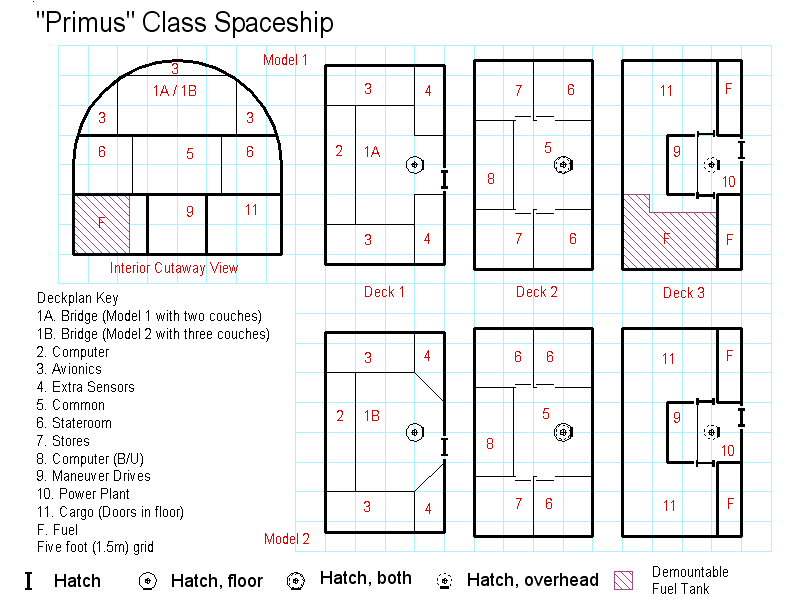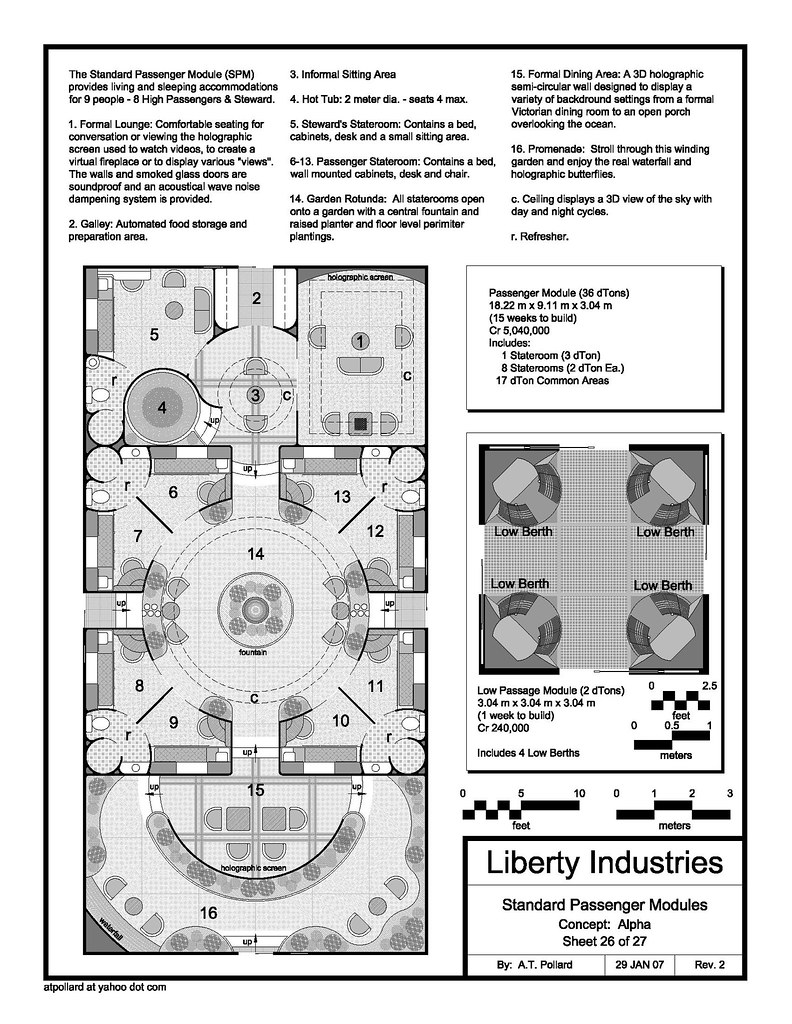ENTRY NO.3: RANDY TYLER - Primus Class Spaceship
HULL
40.000 tons standard, 560.000 cubic meters, Flattened Sphere Configuration
CREW
Pilot, 1 Sensors Operator, [1 Mission Specialist]
ENGINEERING
Jump-0, 1G Manuever, Power plant-1, 0.400 EP, Agility 1
AVIONICS
Bridge, Model/2 Computer
1 Model/2 Backup Computer
HARDPOINTS
None
ARMAMENT
None
DEFENCES
None
CRAFT
None
FUEL
5.200 Tons Fuel (0 parsecs jump and 364 days endurance)
[2.00 Tons Fuel (0 parsecs jump and 140 days endurance)]
On Board Fuel Scoops, No Fuel Purification Plant
MISCELLANEOUS
2.0 Staterooms, 2 Acceleration Couches, 6.000 Tons Cargo
[3.0 Staterooms, 3 Acceleration Couches, 9.20 Tons Cargo]
USER DEFINED COMPONENTS
1 Extra Sensors (2.200 tons, Crew 1, Cost MCr 22.000), 1 Stores (4.000 tons, Crew 0, Cost MCr 1.000)
[1 Extra Sensors (1.70 tons, Crew 1, Cost MCr 23.000)]
COST
MCr 52.217 Singly (incl. Architects fees of MCr 0.517), MCr 41.360 in Quantity
CONSTRUCTION TIME
20 Weeks Singly, 16 Weeks in Quantity
COMMENTS
The first Primus class of spaceship was built by the USA (United States Alliance) soon after gravitic technology was discovered on Novusolum in the Tresastrum trinary system. (These explorations took place about 250 years before the present and about 100 years before Emergence.) Eight ships were built and sent to explore the other two stars 1500 AU's distant in the trinary system. The explorations were set up in a rotation since the trip took about four months. One ship would be enroute,a second would be on station, the third would be returning and the fourth would be in maintainance and refurbishment in preparation for it's journey. Though radio spectrum communications took about eight days to travel the distance between the stars it was welcomed by the crews during their trips. The cargo hold contained a demountable 3.2 dton fuel tank on the maiden voyage of the Aleph and Beth ships in case no suitable refueling source was found in the visited systems. (Though telescopes at Novusolum could detect a 'wobble' in the stars' positions they could not be positive it was caused by orbiting planets. Instead of designing the ships to have a year's supply of fuel, potentially wasting space, a decision to use demountable tanks in the cargo hold was instituted. These seperate tanks could be unused once a suitable gas giant planet was confirmed to exist in the systems.) The remaing cargo space could house several satellites which could be left in orbit around the various planets in the system. During return trips the cargo hold could contain collected samples. The ships do not have artificial gravity and rely on their thrust to proved a gravitational effect during transit. This class of ships were used for about thirty years in various roles after completing six years in exploratory service.
Two different models of the Primus were built. The above specifications are for the Model 1. The Model 2 version has had the extra stores and half a dton of extra sensors removed. An extra crewman, stateroom, and acceleration couch were added. (The area marked as stores in the Model 2 deckplan is considered part of the common area since it contains all three crewman's supplies.) The Aleph, Beth, and Gimel were built as Model 1's; the remainder were built as Model 2's. Model 2 ships do not have facilities to make use of the demountable fuel tanks.
</font><blockquote>code:</font><hr /><pre style="font-size:x-small; font-family: monospace;">Ships in class: Maiden Voyage
Primus-Aleph Lupustellus
Primus-Beth Epopismundus
Primus-Gimel Lupustellus
Primus-Daleth Epopismundus
Primus-He Lupustellus
Primus-Zayin Epopismundus
Primus-Heth Epopismundus
Primus-Teth Lupustellus</pre>[/QUOTE]The Primus-Aleph found gas giants, a planetoid belt and terrestial planets in the Lupustellus system. One of the planets was habitable (E866xxx-x). The Primus-Gimel was the ship that discovered that the planet was inhabited by a primitive (TL 0) civilization of bipedal Canidae. (Efforts by the USA in the World Conference Table (WCT) meetings to protect them from contact quickly failed when ENA (Eastern Nations Alliance) spaceships began to explore and settle colonists. Within twenty years the Canidae civilization would be destroyed and within fifty the race would be extinct, primarily due to ENA actions.)
The Primus-Beth found the Epopismundus system to be something of a puzzle. The only planets found in the system were gas giants, each with a multitude of rings around them and no moons. There were no terrestial planets only planetoid belts. Since all three stars in the Tresastrum system were about the same age the planetary scientists of the day were unable to explain the lack of terrestial planetary formation in the Epopismundus system. (After Emergence the IISS, in conjunction with the Novusolum scientific community, has embarked on research to discover the cause of this. (The IISS is secretly looking for any Ancient artifacts also.)) [/quote]
Detailed DescriptionOriginally posted by Randy Tyler:
Here's my entry:

Flickr Page
Ship: Primus-Aleph
Class: Primus
Type: 40TM1Scoutship (Model 1 and Model 2)
Architect: TylersTools
Tech Level: 7
Specifications in brackets are for the Model 2.
</font><blockquote>code:</font><hr /><pre style="font-size:x-small; font-family: monospace;">USP
SC-0601121-000000-00000-0 MCr 51.700 40 Tons
Bat Bear Crew: 2 [3]
Bat TL: 7
Cargo: 6.0* [9.2] Fuel: 5.2* [2.0] EP: 0.400 Agility: 1
Fuel Treatment: Fuel Scoops
Backups: 1 x Model/2 Computer
Architects Fee: MCr 0.517 Cost in Quantity: MCr 41.360
*A 3.2 dton demountable fuel tank was installed in the cargo
hold on the first two maiden voyages (see below).</pre>
HULL
40.000 tons standard, 560.000 cubic meters, Flattened Sphere Configuration
CREW
Pilot, 1 Sensors Operator, [1 Mission Specialist]
ENGINEERING
Jump-0, 1G Manuever, Power plant-1, 0.400 EP, Agility 1
AVIONICS
Bridge, Model/2 Computer
1 Model/2 Backup Computer
HARDPOINTS
None
ARMAMENT
None
DEFENCES
None
CRAFT
None
FUEL
5.200 Tons Fuel (0 parsecs jump and 364 days endurance)
[2.00 Tons Fuel (0 parsecs jump and 140 days endurance)]
On Board Fuel Scoops, No Fuel Purification Plant
MISCELLANEOUS
2.0 Staterooms, 2 Acceleration Couches, 6.000 Tons Cargo
[3.0 Staterooms, 3 Acceleration Couches, 9.20 Tons Cargo]
USER DEFINED COMPONENTS
1 Extra Sensors (2.200 tons, Crew 1, Cost MCr 22.000), 1 Stores (4.000 tons, Crew 0, Cost MCr 1.000)
[1 Extra Sensors (1.70 tons, Crew 1, Cost MCr 23.000)]
COST
MCr 52.217 Singly (incl. Architects fees of MCr 0.517), MCr 41.360 in Quantity
CONSTRUCTION TIME
20 Weeks Singly, 16 Weeks in Quantity
COMMENTS
The first Primus class of spaceship was built by the USA (United States Alliance) soon after gravitic technology was discovered on Novusolum in the Tresastrum trinary system. (These explorations took place about 250 years before the present and about 100 years before Emergence.) Eight ships were built and sent to explore the other two stars 1500 AU's distant in the trinary system. The explorations were set up in a rotation since the trip took about four months. One ship would be enroute,a second would be on station, the third would be returning and the fourth would be in maintainance and refurbishment in preparation for it's journey. Though radio spectrum communications took about eight days to travel the distance between the stars it was welcomed by the crews during their trips. The cargo hold contained a demountable 3.2 dton fuel tank on the maiden voyage of the Aleph and Beth ships in case no suitable refueling source was found in the visited systems. (Though telescopes at Novusolum could detect a 'wobble' in the stars' positions they could not be positive it was caused by orbiting planets. Instead of designing the ships to have a year's supply of fuel, potentially wasting space, a decision to use demountable tanks in the cargo hold was instituted. These seperate tanks could be unused once a suitable gas giant planet was confirmed to exist in the systems.) The remaing cargo space could house several satellites which could be left in orbit around the various planets in the system. During return trips the cargo hold could contain collected samples. The ships do not have artificial gravity and rely on their thrust to proved a gravitational effect during transit. This class of ships were used for about thirty years in various roles after completing six years in exploratory service.
Two different models of the Primus were built. The above specifications are for the Model 1. The Model 2 version has had the extra stores and half a dton of extra sensors removed. An extra crewman, stateroom, and acceleration couch were added. (The area marked as stores in the Model 2 deckplan is considered part of the common area since it contains all three crewman's supplies.) The Aleph, Beth, and Gimel were built as Model 1's; the remainder were built as Model 2's. Model 2 ships do not have facilities to make use of the demountable fuel tanks.
</font><blockquote>code:</font><hr /><pre style="font-size:x-small; font-family: monospace;">Ships in class: Maiden Voyage
Primus-Aleph Lupustellus
Primus-Beth Epopismundus
Primus-Gimel Lupustellus
Primus-Daleth Epopismundus
Primus-He Lupustellus
Primus-Zayin Epopismundus
Primus-Heth Epopismundus
Primus-Teth Lupustellus</pre>[/QUOTE]The Primus-Aleph found gas giants, a planetoid belt and terrestial planets in the Lupustellus system. One of the planets was habitable (E866xxx-x). The Primus-Gimel was the ship that discovered that the planet was inhabited by a primitive (TL 0) civilization of bipedal Canidae. (Efforts by the USA in the World Conference Table (WCT) meetings to protect them from contact quickly failed when ENA (Eastern Nations Alliance) spaceships began to explore and settle colonists. Within twenty years the Canidae civilization would be destroyed and within fifty the race would be extinct, primarily due to ENA actions.)
The Primus-Beth found the Epopismundus system to be something of a puzzle. The only planets found in the system were gas giants, each with a multitude of rings around them and no moons. There were no terrestial planets only planetoid belts. Since all three stars in the Tresastrum system were about the same age the planetary scientists of the day were unable to explain the lack of terrestial planetary formation in the Epopismundus system. (After Emergence the IISS, in conjunction with the Novusolum scientific community, has embarked on research to discover the cause of this. (The IISS is secretly looking for any Ancient artifacts also.)) [/quote]





































